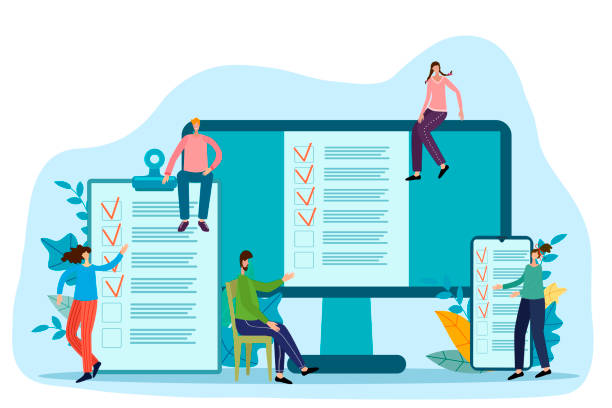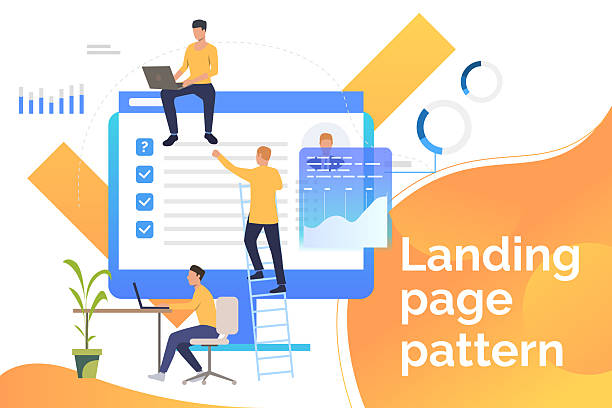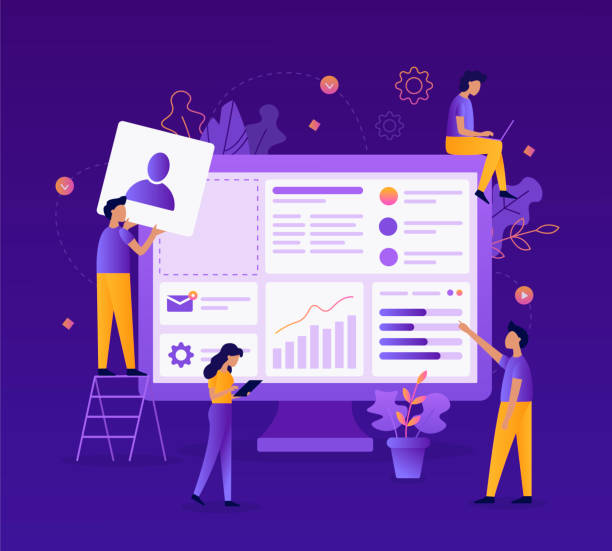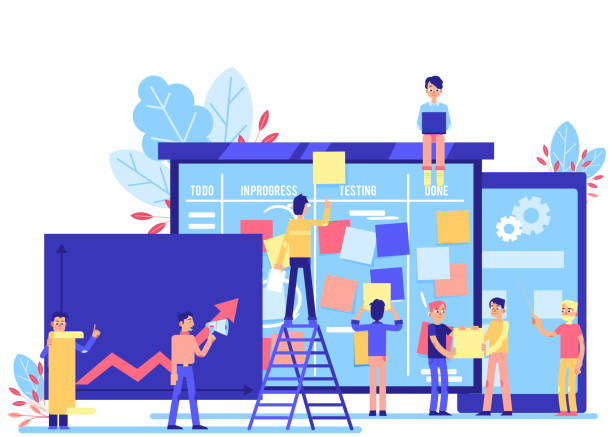Introduction to the Importance of Fast Website Design

In today’s fast-paced world, #website_speed is not just a competitive advantage, but has become an absolute necessity.
Internet visitors expect web pages to load in a fraction of a second, and the slightest delay can mean losing an audience.
This is where the concept of Fast Website Design gains critical importance.
A slow website can severely disrupt user experience, lower a site’s search engine ranking, and ultimately harm a business’s credibility and profitability.
Therefore, focusing on speed optimization from the very initial stages of #website_design and #development is considered a key principle.
This approach not only leads to greater user satisfaction but also has a direct impact on improving SEO metrics and increasing conversion rates.
Understanding the factors affecting speed and implementing correct strategies to increase it is a significant step towards online success.
This article will explore various aspects of Fast Website Design in an #explanatory and #educational manner, providing practical solutions.
Research shows that 80% of customers trust companies with professional websites more. Does your current site inspire this trust?
With Rasaweb’s corporate website design services, solve the problem of customer mistrust and poor online image forever!
✅ Create a professional image and increase customer trust
✅ Attract more sales leads and grow your business
⚡ Get Free Consultation
Key Factors Affecting Website Loading Speed

Multiple factors affect a website’s loading speed, and understanding them is essential for achieving Fast Website Design.
One of the most important factors is #optimized and lightweight_coding.
Excess code, overuse of heavy JavaScript and CSS frameworks and libraries without real need, can severely slow down the site.
Proper management of HTTP requests and reducing their number also plays a significant role.
The more CSS, JavaScript, image, and web font files there are, the more requests the browser must send to retrieve them, leading to slowness.
Furthermore, #website_hosting is one of the main pillars of speed; choosing a high-quality hosting provider with powerful servers and sufficient bandwidth for the expected traffic volume is crucial.
Server resources, its geographical location relative to the target audience, and the use of new technologies like NVMe SSD all have an impact in this area.
Database optimization, content caching, and file compression are other factors that directly affect speed.
In the following sections, we will delve into #specialized solutions for each of these factors to ensure your website loads at maximum speed.
Optimizing Images and Media Content

Large images and media content are often one of the biggest reasons for slow websites.
To achieve a Fast Website Design, #image_optimization is an essential step and a #practical_guide that must be taken seriously.
This process includes compressing images without significant quality loss, using appropriate formats (like WebP for the web, which has a much smaller size than JPEG and PNG), and resizing images to dimensions suitable for web display.
Lazy Loading is also a highly effective technique that only loads images when the user approaches them on the page, which significantly reduces the initial page load.
Furthermore, using Content Delivery Networks (CDN) to serve images and other static files from the server closest to the user dramatically increases loading speed.
These #educational approaches help ensure your website is both visually rich and fast.
Below is a comparative table of common image formats and their characteristics for web image optimization:
| Image Format | Best Use | Browser Support | Compression Level |
|---|---|---|---|
| JPEG | Complex photos with many colors | Excellent (all browsers) | Good (lossy compression) |
| PNG | Graphics with transparency, logos, icons | Excellent (all browsers) | Moderate (lossless compression) |
| GIF | Animated images, simple icons | Excellent (all browsers) | Poor (limited to 256 colors) |
| WebP | Alternative to JPEG and PNG for web | Very Good (modern browsers) | Excellent (lossy and lossless compression) |
The Role of Hosting and CDN in Website Acceleration

Choosing a suitable #hosting service and utilizing a #Content_Delivery_Network (CDN) are two fundamental pillars for achieving a Fast Website Design.
High-quality hosting, which features optimized servers, advanced storage technologies (like SSD or NVMe), and sufficient bandwidth, has a direct impact on server response time (Time To First Byte – TTFB).
Cheap shared web hosting often has limited resources and can slow down your website, whereas Virtual Private Servers (VPS) or dedicated servers provide more control and resources.
In addition to hosting, CDN is a #specialized solution for distributing your website’s content across different parts of the world.
By using a CDN, static content (such as images, CSS, and JavaScript) is served from the server closest to the user, significantly reducing network latency and increasing loading speed.
This is especially crucial for websites with a global audience or extensive media content.
Correct implementation of these two factors prepares your website for an optimal user experience and faster performance.
Does your company’s website create a professional and lasting first impression in the minds of potential customers? Rasaweb, with its professional corporate website design, not only represents your brand’s credibility but also opens a path for your business growth.
✅ Create a powerful and trustworthy brand image
✅ Attract target customers and increase sales
⚡ Get Free Consultation
Code Optimization and Efficient Development Practices

The foundation of a Fast Website Design is clean and optimized #coding.
This includes reducing the size of CSS and JavaScript files through minification (compressing by removing unnecessary characters like spaces and comments) and concatenating them to reduce HTTP requests.
Also, asynchronous loading or deferring JavaScript files that are not essential for the initial page render can help with initial load speed.
Using CSS and JavaScript only where truly needed, and avoiding redundant or deprecated code, is of high importance.
Choosing a lightweight and optimized CMS (Content Management System), such as WordPress with light themes and plugins, is also influential in this regard.
Developers should always pay attention to the performance of the code they write and use profiling tools to identify slow code sections.
These #specialized and #educational approaches help improve overall website performance and ensure that the #site is in its best technical condition.
The Relationship Between User Experience and Website Speed

Have you ever considered how #website_speed can directly affect #user_experience? This is a #thought-provoking_content that is often overlooked.
In fact, a slow website can render even the best visual design and engaging content ineffective.
Today’s users have grown accustomed to speed, and their patience for page loading has drastically decreased.
According to statistics, many users abandon a website that doesn’t load in less than 2-3 seconds.
This not only leads to an increased Bounce Rate but also negatively impacts brand image and business reliability.
A Fast Website Design increases user satisfaction, improves content engagement, and encourages longer stays on the site.
This directly impacts conversion rates, sales, and even customer loyalty.
For this reason, speed optimization should be considered an integral part of the User Experience (UX) strategy.
This is an #analytical perspective that shows speed is more than just a technical aspect; rather, it is a crucial factor in building a successful online experience.
Tools for Measuring and Improving Website Speed

To achieve a Fast Website Design, we first need to know how our website currently performs and which sections need improvement.
Fortunately, there are numerous #tools for #measuring website speed and identifying its weaknesses.
These tools, some free and some paid, provide #specialized information and #practical_guidance.
Among the most famous of these tools are Google PageSpeed Insights, GTmetrix, WebPageTest, and Pingdom Tools.
Each of these tools provides various metrics such as full load time, TTFB, performance scores, and a comprehensive list of optimization recommendations.
Regular use of these tools and monitoring website speed scores is an integral part of the optimization process.
They not only help you identify problems but also evaluate the impact of the changes implemented.
Below is a table of some popular tools and their main features to assist in website performance improvement.
| Tool Name | Key Features | Main Focus |
|---|---|---|
| Google PageSpeed Insights | Performance score (mobile and desktop), Core Web Vitals, Google’s recommendations | User experience and SEO |
| GTmetrix | Waterfall Chart, performance history, loading video | Deep performance analysis |
| WebPageTest | Tests from different global locations, browser and connection speed simulation | Performance testing in real-world scenarios |
| Pingdom Tools | Waterfall chart, breakdown analysis, uptime monitoring | Comprehensive analysis and monitoring |
The Impact of Fast Websites on SEO and Business

Did you know that #website_speed directly affects your #search_engine_ranking and, consequently, your #business_success? This is important #news for every business owner.
Search engines like Google consider page loading speed as a ranking factor.
Faster websites not only provide a better user experience but are also preferred by Google’s algorithms and appear higher in search results.
This means that a Fast Website Design can drive more organic traffic to your website.
In addition to SEO, site speed has a direct impact on conversion rates.
Studies have shown that even a one-second delay in page loading can reduce conversion rates by up to 7%.
This means losing potential customers and revenue.
Therefore, investing in speed optimization is not just a technical investment, but a strategic investment in the future of your business.
This is an #economic and #business analysis that should not be overlooked.
Did you know that a poor corporate website loses you many opportunities daily? Solve this problem forever with professional corporate website design by Rasaweb!
✅ Create a powerful and trustworthy image of your brand
✅ Attract targeted new customers and increase sales
⚡ [Get Free Website Design Consultation]
Common Mistakes in Website Design and Ways to Prevent Them

On the path to achieving a Fast Website Design, many developers and website owners make #common_mistakes that can severely reduce site speed.
Understanding these mistakes and #guidance on preventing them is crucial.
One of the biggest mistakes is the lack of image and video optimization, as mentioned earlier.
Using high-resolution images with unsuitable dimensions, without compression, can drastically increase page size.
Another mistake is loading too many unnecessary scripts and plugins that slow down website performance.
Choosing an unsuitable and low-quality hosting is also a common mistake that cannot be compensated for even with the best client-side optimizations.
Lack of content caching, failure to use a CDN for static content, and lack of file compression (like Gzip) are also factors that directly affect speed.
Furthermore, irregular monitoring of site performance and ignoring warnings from speed analysis tools can lead to an accumulation of problems and a severe drop in speed over time.
This section, in an #educational and #explanatory manner, helps you avoid these pitfalls and have an optimized and fast website.
The Future of Website Design and New Speed Trends

The world of #web_design is constantly evolving, and with the emergence of new technologies, #website_speed standards are also continuously changing.
This is #news_content and #entertaining_content that addresses future trends.
One of the most important future trends in Fast Website Design is a greater focus on Google’s #Core_Web_Vitals, which measures actual user experience from a speed perspective.
Technologies like Service Workers for creating offline capabilities and improving reload speed, as well as the wider adoption of HTTP/3, a newer protocol for web communications built on QUIC, will play significant roles in the future.
The emergence of new development tools, lighter and more optimized frameworks, and the growth of Artificial Intelligence in automated website optimization can also bring about significant developments.
New architectures like Jamstack, which is based on JavaScript, APIs, and Markup and focuses on generating pre-rendered static pages, are also rapidly gaining popularity.
These approaches promise faster and more responsive websites in the future and show that the importance of web optimization will never diminish.
Frequently Asked Questions
| Question | Answer |
|---|---|
| What is the concept of Fast Website Design? | It refers to the process of building a website whose pages load at high speed and in minimal time for users. |
| Why is website speed important? | Website speed is crucial for a better user experience, reducing visitor bounce rates, increasing page views, and improving search engine rankings (SEO). |
| What factors affect website loading speed? | Image and file sizes, unoptimized coding, server speed and location, not using caching and CDN, and a large number of HTTP requests. |
| What is the role of images in website speed? | High-volume images can severely slow down a website. They should be compressed, optimized, and used in appropriate formats. |
| Is host server speed important? | Yes, server response speed directly impacts the initial site loading time. Choosing suitable hosting is very important. |
| How does website coding affect speed? | Clean, optimized, minified, and error-free coding reduces file sizes and increases processing speed. |
| How does using Caching help? | Caching allows the user’s browser to store some website information, so on subsequent visits, not everything needs to be reloaded, and the site displays faster. |
| Do extra plugins and scripts slow down website speed? | Yes, excessive or improper use of plugins, widgets, and extra scripts can cause the site to slow down. |
| How can website speed be tested? | By using reputable online tools such as Google PageSpeed Insights, GTmetrix, or Pingdom Tools. |
| What are the key tips for fast website design? | Image optimization, using CDN, enabling caching, reducing HTTP requests, optimizing CSS and JavaScript, and choosing quality hosting. |
And other services of Rasaweb Advertising Agency in the field of advertising
Smart Data Analysis: A fast and efficient solution for digital branding with a focus on attractive UI design.
Smart Brand Identity: A combination of creativity and technology to increase sales through precise audience targeting.
Smart Marketing Automation: A novel service to enhance SEO ranking improvement through key page optimization.
Smart SEO: A fast and efficient solution for online growth with a focus on using real data.
Smart Google Ads: A professional solution for customer acquisition with a focus on precise audience targeting.
And over a hundred other services in the field of internet advertising, advertising consultation, and organizational solutions
Internet Advertising | Advertising Strategy | Advertorial
Resources
Website Speed OptimizationWhy Website Speed is Important?Benefits of Fast Web DesignChallenges of the Digital Age and Web
?With Rasaweb Afarin, have a powerful presence in the digital world! From professional corporate website design to SEO optimization and social media management, we are your comprehensive digital marketing solution.
📍 Tehran, Mirdamad Street, next to Bank Markazi, Kazeroun Jonoubi Alley, Ramin Alley, No. 6




